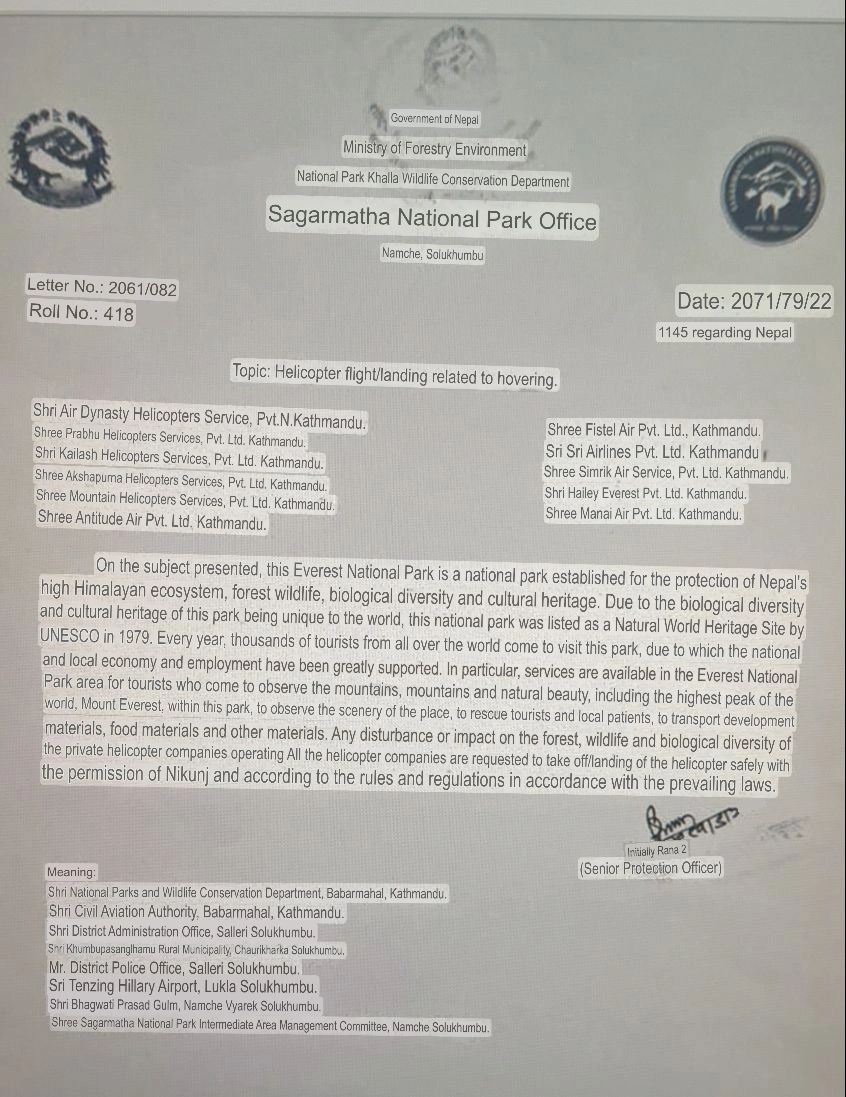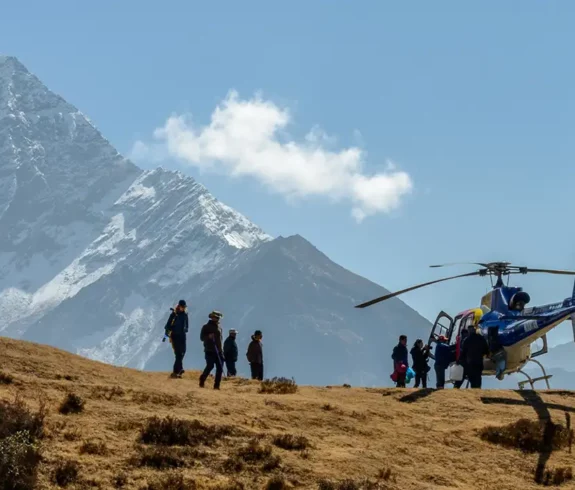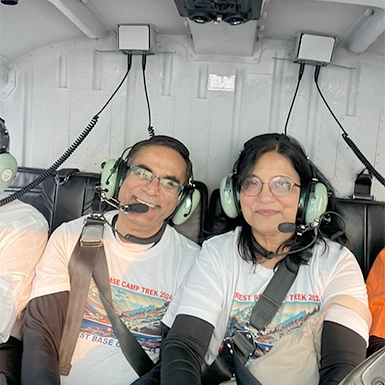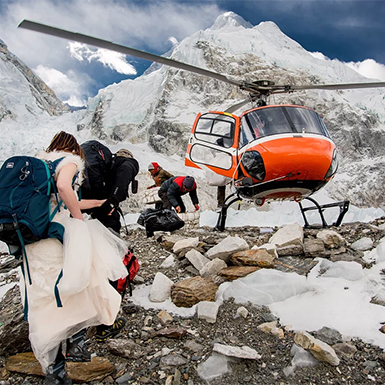The helicopter ban lifted in Everest Region signifies a pivotal moment for Sagarmatha National Park, a UNESCO World Heritage Site renowned for its extraordinary natural beauty. This decision permits the resumption of commercial helicopter flights within the park and its buffer zone, addressing concerns over accessibility while emphasizing the need for sustainability. Initially imposed on January 1, the ban sought to tackle critical issues like noise pollution, disruptions to wildlife habitats, and the negative impact of unregulated helicopter activity on local livelihoods. Now, with stricter regulations, the region aims to balance tourism growth with preserving its fragile ecosystem and cultural heritage.
Local authorities, including the Khumbu Pasanglhamu Rural Municipality, the Sagarmatha National Park Buffer Zone Management Committee, and other stakeholders, supported the helicopter ban in the Everest Region. These groups advocated for stricter controls on helicopter operations, citing the need to preserve the region’s fragile ecosystem and provide sustainable opportunities for local communities. However, the decision was not without controversy.

Helicopter operators, represented by the Civil Aviation Authority of Nepal (CAAN), strongly opposed the restrictions. They argued that air travel regulations fall under CAAN’s jurisdiction and cannot be implemented without a formal government directive. The disagreement highlighted the complexities of balancing tourism development with environmental protection in one of the world’s most visited trekking destinations.
Now that the Everest Region has lifted the helicopter ban, flights are set to resume under stricter guidelines. These regulations aim to minimize helicopter operations’ environmental and social impacts while supporting the region’s tourism economy. The new policies include designated flight paths, altitude restrictions, and daily flight limits, ensuring a balance between accessibility and sustainability.
This decision offers a renewed opportunity to welcome tourists while maintaining the integrity of the Everest Region’s unique landscape. With collaboration among local stakeholders, aviation authorities, and environmental groups, lifting the ban signals a fresh commitment to sustainable tourism practices in this globally cherished destination.
Background of the Ban
The helicopter ban lifted in the Everest Region has sparked discussions about balancing tourism growth with environmental protection. The initial ban was introduced to address the adverse effects of “uncontrolled” helicopter operations, which saw up to 100 flights daily during peak seasons. This excessive activity created significant noise pollution, disrupting the tranquility of Sagarmatha National Park and forcing wildlife, including endangered species like snow leopards and red pandas, to abandon their habitats.
Senior Conservation Officer Sushma Rana emphasized the environmental toll, highlighting how unauthorized helicopter landings in sensitive areas harmed the park’s biodiversity. Local stakeholders supported the ban, advocating for a shift toward trekking-based tourism, which generates sustainable employment opportunities for guides and porters while minimizing environmental impact.
However, the ban faced strong opposition from helicopter operators, represented by the Airlines Operators Association of Nepal (AOAN). They criticized the restrictions, citing failed negotiations with local authorities and challenges such as obstructed helipads and threats to crew members. The AOAN even threatened to suspend all flights to the Everest Region, including essential Short Take-Off and Landing (STOL) services, if operational issues were not addressed.
Since the ban has been lifted, stricter regulations aim to balance accessibility and environmental sustainability, fostering hope for responsible tourism in the Everest Region.

Reversal of the Ban
The helicopter ban lifted in the Everest Region responded to mounting tensions between aviation operators and local stakeholders. The Airlines Operators Association of Nepal (AOAN) played a pivotal role in this decision, suspending helicopter services and warning of a broader flight suspension, which pressured authorities to reevaluate the restrictions. Initially introduced to address environmental concerns and unregulated operations, the ban had significantly impacted tourism and accessibility in the region.
On January 6, Sagarmatha National Park issued a circular allowing helicopter operations to resume, but with stricter guidelines. Operators were reminded of their responsibilities, including compliance with regulations, payment of required fees, and obtaining permissions for all activities within the park, such as landings, take-offs, and hovering. These measures aim to ensure responsible operations while safeguarding the park’s ecosystem. The decision highlights a critical step toward balancing tourism growth with environmental sustainability in the Everest Region.

Balancing Tourism and Conservation
Mount Everest and its surrounding region, a UNESCO World Heritage Site, remain among the most sought-after destinations for adventure enthusiasts and nature lovers. Spanning 1,148 square kilometers, with an additional 275 square kilometers of buffer zone, this area is a haven for diverse wildlife and a cornerstone of Nepal’s tourism industry. Helicopter services have long been vital to the region, providing swift access to remote areas, supporting trekkers, and facilitating emergency evacuations.
Recently, the helicopter ban lifted in Everest Region has reignited hopes for tourism recovery. While the move is expected to revitalize the local economy, it significantly emphasizes sustainability. To address previous concerns about noise pollution and environmental stress, authorities have implemented new operational guidelines.
Flights must now follow designated paths to reduce disruptions to wildlife and local communities. Strict monitoring has been introduced to ensure compliance, with unauthorized landings no longer permitted. Additionally, a cap on daily flights aims to manage air traffic and minimize ecological strain.
This carefully regulated resumption of helicopter services signals a commitment to balancing accessibility with environmental preservation, ensuring that this majestic region remains protected for future generations.

Impact on Local Communities
The decision to lift the helicopter ban in the Everest Region has sparked mixed reactions among local communities. Initially, the ban was implemented to prioritize trekking-based tourism, providing more excellent employment opportunities for guides and porters who rely on traditional trekking routes for their livelihood. By discouraging helicopter services, authorities aimed to reduce dependency on air travel and promote more sustainable tourism practices in the region.
With the helicopter ban lifted in Everest Region, some residents are optimistic about the economic benefits that increased helicopter tourism could bring. The influx of visitors, attracted by the convenience and breathtaking aerial views, is expected to boost local businesses, including lodges, restaurants, and souvenir shops.
However, not all locals are in favor of the move. Concerns remain about the long-term impact on the region’s tranquility, one of its major draws for trekkers. The noise and environmental effects of helicopters could also affect the wilderness experience and disrupt the fragile ecosystem.
Mingmachhiri Sherpa, Chairman of Khumbu Pasanglhamu Rural Municipality, previously advocated for the ban to encourage sustainable tourism and minimize environmental stress. While he has yet to comment on the recent developments, the debate underscores the need for a balanced approach to benefit local livelihoods and environmental preservation.

Future of Tourism in the Everest Region
The future of tourism in the Everest Region hinges on striking a delicate balance between accessibility and environmental preservation. With the helicopter ban lifted in Everest Region, the decision opens up new opportunities to enhance tourism while raising questions about sustainability. Helicopter services are expected to improve access for time-constrained travelers and provide a convenient option for those seeking to explore the majestic landscapes without enduring the physical challenges of trekking.
Sagarmatha National Park continues to be a cornerstone of Nepal’s tourism economy, drawing thousands of trekkers and climbers annually. However, its fragile ecosystem, home to endangered species and pristine natural beauty, demands careful stewardship. All stakeholders, including aviation operators, local communities, and conservation groups, must collaborate to ensure responsible tourism practices.
New regulations, such as designated flight paths and stricter monitoring, aim to mitigate the environmental impact of helicopter operations. Additionally, promoting eco-friendly tourism initiatives and educating visitors on conservation efforts will play a pivotal role in preserving this iconic region.
The helicopter ban’s reversal provides an opportunity to redefine tourism in the Everest Region, fostering growth while ensuring that its natural and cultural treasures remain intact for generations to come.
Helicopter Ban Lifted in Everest Summary:
The helicopter ban lifted in Everest Region has opened a new chapter for tourism, blending accessibility with sustainability. Initially implemented to address noise pollution, wildlife disturbances, and over-reliance on helicopters, the ban sought to protect Sagarmatha National Park’s fragile ecosystem. The UNESCO World Heritage Site region spans 1,148 square KM and is vital to Nepal’s tourism economy. The ban’s reversal comes with stricter regulations, including designated flight paths, daily flight caps, and rigorous monitoring to minimize environmental and social impacts.
While the move is expected to boost tourism and support local businesses, it has sparked mixed reactions. Some locals welcome the economic benefits, while others worry about the impact on the region’s tranquility and traditional trekking routes. Stakeholders must work together to ensure responsible tourism practices, including aviation operators, local communities, and conservation groups. By balancing helicopter services with conservation goals, this decision offers a chance to redefine sustainable tourism in the Everest Region while preserving its unique natural and cultural heritage for future generations.
Reference: Sagarmatha National Park Lifts Ban on Commercial Helicopter Flights



